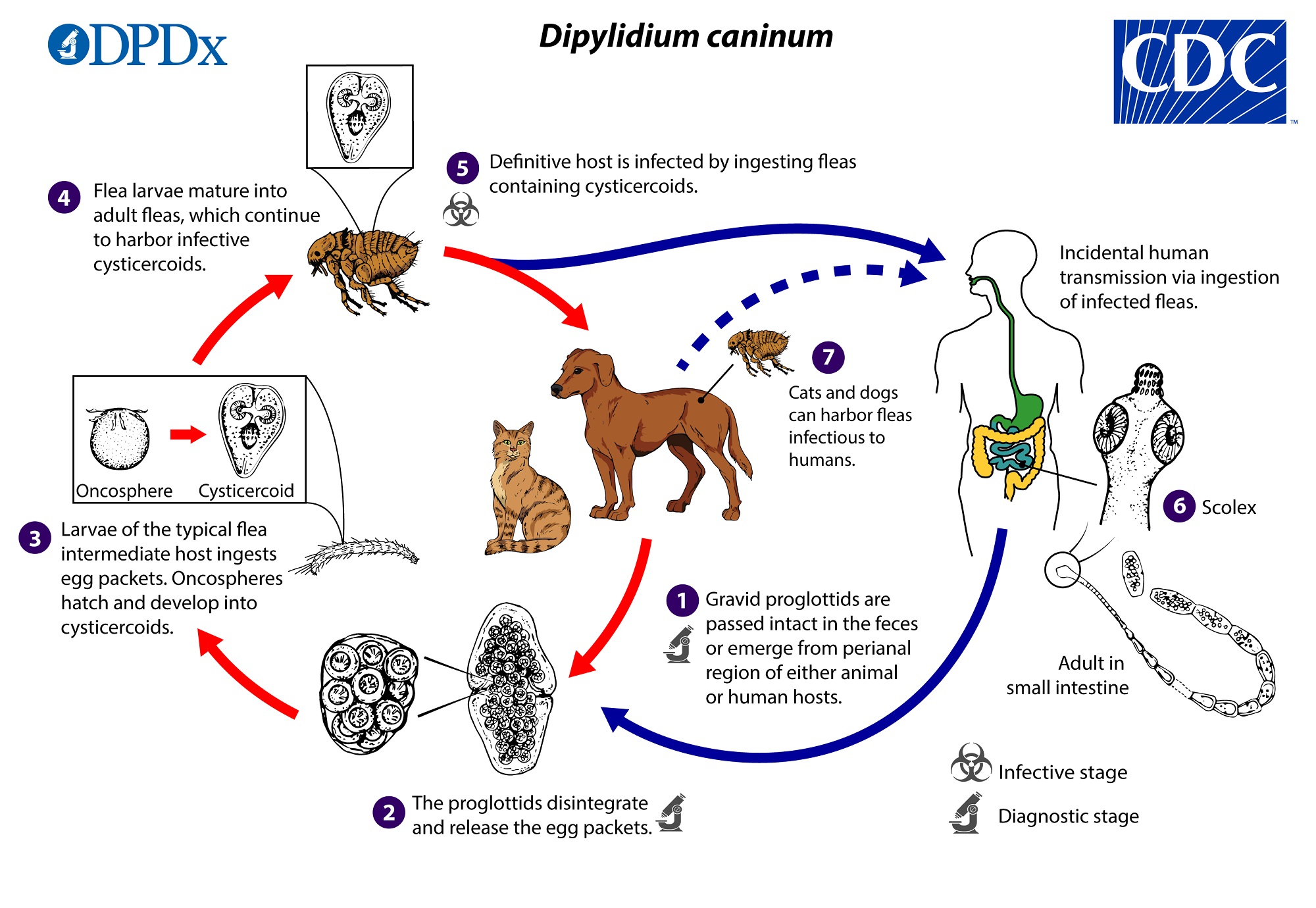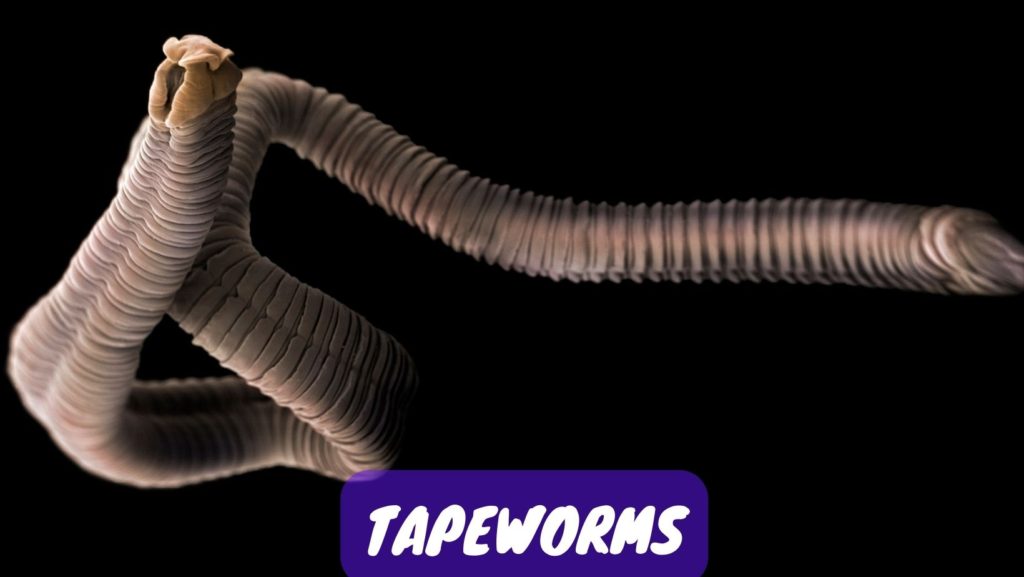Worried about the prevention of Tapeworm infection in your dog? Or thinking about where did your dog get that Tapeworm infection from? If queries like these are occupying your mind, then you have come down to the right place.
Here is an elaborated guide discussing Tapeworm infection in Dogs. From how these tiny parasites appear to what’s the way to treat them, every single piece of information is mentioned below.
So why wait? Read on all about Tapeworm in Dogs and help your poor Canine with the infection.

Contents
- How do dogs get tapeworms- Causes, Treatment, Prevention?
- Tapeworms in Dogs – Symptoms, Causes, Treatments
- Tapeworm Infection in Dogs- Treatment
- Tapeworm Infection in Dogs- Prevention
- Tapeworms- 7 Facts and Reasons
- How contagious are tapeworms in dogs?
- Can tapeworms be passed from dog to human?
- How long does a dog have tapeworms before you see them?
- Can a dog fully recover from Tapeworms?
- How much does it cost to treat Tapeworms?
- How long do tapeworm eggs live on a carpet?
- Do dogs poop out Tapeworms?
- Will Tapeworms Kill a Dog?
- Should I adopt a Tapeworm Positive Dog?
- Wrapping up…
How do dogs get tapeworms- Causes, Treatment, Prevention?
Tapeworms are one of the common intestinal parasites that cats and dogs suffer from. These intestinal worms belong to the cestode family and have many subspecies across the world. Though the one that impacts dogs the most is ‘Dipylidium Caninum’.
Worm infection is undoubtedly the nastiest thing that dogs can suffer from. Be it a Tapeworm infection or other common parasitical infections; it can hamper a dog’s gastrointestinal health and play with its entire system.
Tapeworm infection in dogs isn’t usually dangerous or life-threatening, but during severity, it can definitely trouble the survivor.
Tapeworms in Dogs – Symptoms, Causes, Treatments
Here are some more insights on Tapeworm infection in Dogs.

Tapeworm Infection in Dogs- Symptoms
Tapeworm infection in dogs doesn’t necessarily have any visible symptoms, but during criticality, dog owners might observe some. For instance,
- Worm Segments in Your Dog’s Poop (The most common and evident)
- Scooting and dragging of the bottom.
- Vomiting
- Diarrhoea
- Weight loss even when eating normally
- Lethargy
- Distended abdomen
- Dullness in the coat
- Worms around dog’s anus

Tapeworm Infection in Dogs- Causes
One of the only and possibly the most common culprits of spreading tapeworm in dogs is accidental ingestion of fleas.
It possibly happens while grooming when dogs lick themselves and swallow the fleas present in their fur.
Dogs can also get tapeworm infection by eating flea larvae, tapeworm eggs, or stools of an infected animal.
Tapeworm Infection in Dogs- Diagnosis
The normal or clinical diagnosis of Tapeworm infection in dogs is quite simple. The Vet in charge will the white, mobile tapeworm segments in the faeces or crawling around the anus of the dog.
Since these worm segments are occasionally seen around a dog’s anus, even pet parents can observe them at home.
However, to confirm the case, a stool test is extremely necessary. If you suspect your dog of tapeworm infection, take his stool sample for diagnosis at the doctor. In common cases, the worms are visible on the stool surfaces.
Whereas in other cases, the Vet in charge will use a special solution, dissolve the stool sample and observe it under a microscope.
In some cases, even when the dog is suffering from tapeworm infection, it might not appear in the diagnosis. It is since dogs do not pass worms in every stool. That is why, at times, two or multiple diagnoses are necessary.
Tapeworm Infection in Dogs- Treatment
The only method of eliminating tapeworm infection in dogs is through oral medications.
After diagnosing the infection, the Vet will suggest some deworming medications like fenbendazole, epsiprantel, and nitroscanate. The specific medicine depends upon the kind of infection and its severity.
- Mix the daily dose with a small amount of your dog’s usual food. Your dog should eat all of the medicated food. If feeding dry dog food, it may need to be moistened to aid mixing
- Repeat the daily dose for 3 days in a row (each packet is a daily dose depending on your dog's size)
- If dog's weight is in-between suggested dosing sizes, it's safe to use the next higher size. For example a a 15lb dog should be treated with the 2gm packet
- Safe for all dogs 6 weeks and older, including pregnant dogs
- Deworming schedules may vary depending on the climate where you live and the activity of your dog
Or, in severe cases where the infection has to lead to intestinal blockages, other medical measures might become necessary.
Tapeworm Infection in Dogs- Prevention
The most critical and successful measure to prevent tapeworm infection in dogs is Flea Control.
Or, while your dog is out for a walk or a game of fetch, avoid leaving him unsupervised.
Ensure you clean your house, garden, and backyard every time your dogs do their business.
Lastly, follow a regular deworming schedule for your dogs regardless of any infection affecting them or not.
Tapeworms- 7 Facts and Reasons
- Humans can get tapeworm infection by consuming raw or undercooked meat of animals who are suffering from the infection.
- Deworming drugs usually kill tapeworms within a few days of consumption.
- Dogs, Cats, and Humans cannot transfer tapeworms to other living beings directly. It needs a hosting flea for transmitting infection from one animal to other humans/animals.
- Tapeworms have suction cups and grappling hooks in their head.
- Tapeworms wear their stomach outside their body.
- Tapeworms normally need more than one host.
- Tapeworms have been around for a very long time, and they can grow huge.
How contagious are tapeworms in dogs?
Tapeworms are highly contagious in dogs, and it isn’t a surprise if your dog is frequently getting them. However, tapeworms cannot transfer from dog to dog. Instead, it needs an immediate host, like ‘Fleas’ for transferring from one living being to another.
Risks and conditions like raw, uncooked meat and poor hygiene can also lead to tapeworm infection spreading amongst dogs.
Can tapeworms be passed from dog to human?
Yes, it is quite possible for humans to get tapeworm infection from dogs. However, the risk of infection in humans is extremely low due to two major reasons,
Firstly, there are several varieties of tapeworm that dogs suffer from. However, not all of them are transmissible to humans.
Secondly, dogs cannot directly transfer tapeworms to humans, and it requires an immediate host, like Fleas, for the task.
The two common types of Tapeworms that attack humans include Dipylidium caninum and Echinococcus multilocularis.
The former is found in both dogs and cats. It can transmit to humans even when an infected dog licks you. At the same time, the latter is more common in cats and transferred due to humans due to accidental ingestion of worm larvae/ eggs.
In simpler words, the transmission of Tapeworms from dogs to humans happens due to due to close physical contact. It is more common in those households where pet parents allow their dog to share the same bed and are more into cuddling their Canine.
How long does a dog have tapeworms before you see them?
Commonly, it takes about two to three weeks before you may observe tapeworm infection symptoms in your dog. It is the time frame between when tapeworms were swallowed and by the time they were developed inside the dog’s system.
How long does it take to get rid of tapeworms in dogs?
The treatment for tapeworms in dogs is pretty straightforward, and it does not take much time. It may take a week or two for dogs to get fully rid of tapeworm infection.
Though in severe cases when the worms are in large number, multiple doses and a few more weeks will do the required.
Can a dog fully recover from Tapeworms?
Tapeworms aren’t life-threatening, and they would rarely cause any serious symptoms or effects in healthy dogs.
Any Canine suffering from a tapeworm infection can survive through it and fully recover within some time.
However, dogs who are too old or already suffering from some kind of ailment might have a hard time recovering from a Tapeworm infection.
Tapeworm infection can be fatal if left untreated. Though in most cases, dogs, cats, and humans usually survive through it.
How much does it cost to treat Tapeworms?
Treating a Tapeworm infection in dogs can cost anywhere from $20 to $50.
However, if the treatment is accompanied by a veterinary visit and diagnosis (faecal analysis), the cost may shoot up to $150.
The cost of treating Tapeworms in dogs also depends upon the severity of the infection and the area you are getting the treatment.
How long do tapeworm eggs live on a carpet?
Yes, Tapeworm eggs can survive outside fog on the carpet for up to eight months. Most of them lie own alive for a long time while waiting for their intermediate hosts.
That is why, while your dog is suffering from worm infection, it is important to maintain the hygiene and sanity of the house every single day.
Especially if you have other pets or small kids in the house, do take care of cleanliness as it is the only way you can prevent the spread.
Do dogs poop out Tapeworms?
Yes, an infected dog may likely pass segments of tapeworms in their stool. These worms will resemble thin rice grains.
However, it is possible that dogs might not poop out tapeworms with every stool despite suffering from severe infection.
At times, pet owners can spot dogs suffering from tapeworm infection may scoot their bottom along with the ground.
It is one of the signs that your dog is suffering from an infection, and it is time for a quick diagnosis and treatment.
Will Tapeworms Kill a Dog?
Tapeworm infections aren’t usually too dangerous, and thus fatal cases with them are rare. Though, if left untreated, severe tapeworm infection can hamper a dog’s growth, play with his health, and even cause death in some cases.
However, Tapeworm infection alone can rarely cause death in dogs, and it is some other underlying illness that might have supported the cause.
Should I adopt a Tapeworm Positive Dog?
Individuals who can invest their interest, time, and effort can definitely go for adopting a Tapeworm Positive dog.
However, since worm infections in dogs can propose a series of harm to humans, one has to behave extremely cautiously and thoughtfully.
Proper sanitization and hygiene practices around the dog are mandatory. And until and unless the worm-positive dog recovers, maintaining physical distance too us is a must.
- How Do Dogs Get Whipworms? 6 Facts and Reasons
- Can Dogs Get Worms from Cats? 10 Ways Cats Infect Dogs
- 10 Surprising Places Dogs Get Worms from
Best Tapeworm Dewormer for Dogs
- Dewormer for Dogs: PetArmor 7 Way Chewable De-Wormer for dogs treats and controls 7 species of worms: 2 types of tapeworms, 2 types of roundworms, and 3 types of hookworms
- Vet Quality: These vet-quality tablets are safe for puppies 12 weeks or older, and large dogs 25.1 to 200 lbs
- Dewormer Tablets: PetArmor broad spectrum dewormer comes in chewable tablets, making it easy and convenient to give to your dog
- How to Use: Watch your dog for a few minutes after dosing to make sure the chewable dog dewomer is not rejected and the full dose of dewormer is eaten
- Recommended Use: For best results with any PetArmor dog dewormer read and follow label intructions. If you need to retreat your dog, we recommend consulting with your veterinarian and have them perform a fecal test to rule out any other issues or parasites
- BROAD SPECTRUM: This dog dewormer treats and controls two types of tapeworms, two types of roundworms, and three types of hookworms.
- OVER-THE-COUNTER WORM MEDICINE FOR DOGS: SENTRY HC WORM X PLUS 7 Way De-Wormer contains two active ingredients found in veterinary brands: pyrantel pamoate and praziquantel and is available without a prescription.
- EASY TO USE: These tasty chewable SENTRY DeWormer tablets can be given to your dog with or without food.chewable tablets are easy to use and can be given to your dog with or without food.
- DEWORMER FOR SMALL DOGS & PUPPIES: 12 weeks and older, weighing 6 to 25 pounds.
- TREAT REGULARLY: Utilize subscribe and save to regularly treat your pet against all three types of hookworms.
- Easy-to-give beef-flavored chewable tablet
- Broad-spectrum dewormer
- Effective against tapeworms, roundworms, hookworms and whipworms
- For use in dogs over 4 weeks of age
- Warning: Keep out of reach of children
- 3-count bottle of tapeworm dewormer for cats
- Easy effective way to remove common tapeworms in cats
- Tablets may be crumbled and mixed with food or taken by mouth
- Tapeworm Dewormer for Cats will remove the common tapeworms, Dipylidium caninum and Taenia taeniaeformis, from cats and kittens
- For use in cats over 6 weeks of age
- For Treatment and control of roundworms hookworms whipworms and tapeworms
- Can be used on young puppies debilitated dogs pregnant females.
- Safe for puppies at least 6 weeks old
- Store at controlled room temperature (68-77°F)
- Treats More Worms Why settle for less? Treat and control worms of greatest risk to the outdoor dog including Taenia Tapeworms, Hookworms, Roundworms, and Whipworms
- Using Fewer Drugs SAFE-GUARD treats these worms with only one compound, fenbendazole; So you can treat more with less, minimizing your dog’s chemical exposure
- Easy to feed granules that mix into food
- Safe-Guard treats against Tapeworms, Roundworms, Hookworms, and Whipworms
- Safe-Guard treats against Tapeworms, Roundworms, Hookworms, and Whipworms
- Easy to feed granules that mix into food
- Safe for young puppies over the age of 6 weeks, pregnant dogs, and heartworm infected dogs
- Must be administered for 3 consecutive days and is effective for 6 months
- Each package contains three 1-gram pouches
- Safe-Guard treats against Tapeworms, Roundworms, Hookworms, and Whipworms
- Easy to feed granules that mix into food
- Safe for young puppies over the age of 6 weeks, pregnant dogs, and heartworm infected dogs
- Must be administered for 3 consecutive days and is effective for 6 months
- Each package contains three 2-gram pouches
- Safe Guard treats against Tapeworms, Roundworms, Hookworms, and Whipworms
- Easy to feed granules that mix into food
- Safe for young puppies over the age of 6 weeks, pregnant dogs, and heartworm infected dogs
- Must be administered for 3 consecutive days and is effective for 6 months
- Each package contains three 4-gram pouches
- Dog wormer
- Broad spectrum wormer
- Effectively removes hookworms and roundworms
- Broad Spectrum Wormer
Wrapping up…
Worm infection is common in dogs; however, this fact shouldn’t stop you from avoiding deworming and flea prevention.
Despite how obvious it is for dogs to catch worms, practising hygiene can save them for the longest time.
Thankfully, tapeworm infection rarely causes severe complications for dogs, and thus there is nothing major to worry about.











